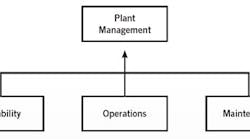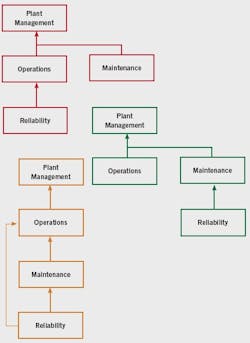Traditional maintenance metrics, such as improved tool time and schedule compliance, are not enough to achieve top performance. Some organizations develop robust planning and scheduling departments to improve tool time and repair broken equipment more efficiently. However, those organizations are missing out on a benefit that is up to five times greater than faster repairs. Rather than fixing broken equipment faster, try instead to extend the life of the equipment and achieve top performance using a reliability-centric approach.
A reliability-centric organization makes reliability the focus of the maintenance and operations departments. The company must have a strong, independent reliability leader who not only looks at traditional reliability improvements but also influences and leads the organization’s operations, maintenance, capital, and turnaround functions to improve overall corporate performance, with the motto: “Engineer it right, keep it running, and repair it right.” This centralized reliability czar must have the full support and buy-in from the leaders of the operations and maintenance departments, as well as executive management.
This three-part series presents case studies about organizations focused on integrating their reliability efforts and their successes and failures in improving availability and reliability. One organization’s focus on reliability resulted in doubling the mean time between repairs (MTBR), reduced maintenance costs, improved capital procurement, and installation, and faster shutdown and turnaround performance.
Part I of this series covers the reasons for changing from a production- or maintenance-focused organization to a reliability-focused organization. Part II will cover the key elements for operations and maintenance in a reliability-focused organization. And Part III will cover the key elements for the reliability department, along with a brief discussion on leadership.
Click here to read Part II | Click here to read Part III
Introduction
Manufacturing facilities strive for first-quartile or world-class operations to improve production, profits, safety, and environmental performance. To reach this goal, many companies focus on world-class maintenance, with little or no regard for improving their reliability capabilities. These companies spend time, effort, and money to develop their maintenance organizations by hiring planners, schedulers, material coordinators, maintenance supervisors, and data clerks, all with the goal of increasing the efficiency of repairing the asset’s equipment. Doubling tool time is a worthy goal, but is it enough for an organization to fix it faster? What about not breaking the equipment in the first place? What would be the impact on the organization if it focused on improved reliability and made reliability the focus of the maintenance and operations departments?
For example, take a plant that repairs 500 pumps per year at a cost of $20,000 per repair for a total repair cost of $10 million per year. Assuming a quarter of the cost is labor, by doubling the tool time the plant may be able to reduce labor costs by $1.25 million per year:
500 pumps × $5,000 labor cost = $1,250,000 saved
2 tool time factor
But what if the plant focused on reliability and doubled the mean time between repairs (MTBR) instead? That would be equivalent to cutting the number of repairs in half and would result in $5 million in savings per year — four times the impact on costs. In addition, the improved MTBR numbers translate into an increase in availability and hence increased production volumes of salable product. As a general rule, if your asset’s MTBR is less than six years, gains in reliability will surpass any gains in maintenance efficiency. Of course, you still need to improve maintenance efficiencies, but a reliability-centric approach yields far superior overall results. Sadly, many companies still focus on maintenance even though investments in reliability have better corporate returns.
What does a reliability-centric organization look like? A reliability-centric organization can be modeled using the traditional three-legged stool, in which reliability is sturdily supported by the operations, maintenance, and reliability departments. The maintenance group focuses on the fix-it-right approach, Operations tries its best to keep it running, and the separate reliability department provides the technical expertise to engineer it right, preferably from the start.
Need for a reliability department
Do we really need to establish another whole department? Isn't that expensive? Can't we just focus on reliability as an organization through our practices? You can try, but without a dedicated reliability department with a strong leader and proper reporting structure, results will be limited.
{pb}| Craig D. Cotter, PE, CMRP, is a maintenance specialist with 21 years of experience in refining, chemical, and E&P organizations in the areas of reliability engineering and maintenance management. He’s a member of SMRP and the Vibration Institute with a Category III certification. Contact him at (281) 413-9475 or [email protected]. |
Some companies scatter reliability concepts throughout their maintenance and operations departments, hoping this will achieve reliability. Although some gains in reliability have been seen, the gains tend to be limited and not sustained. The reason for this is that maintenance’s focus is taking the time to repair things well, whereas operations’ focus is to get the process back on production quickly, so these two goals are at odds with each other. When the damaged unit is taken off-line, there is no time to consider reliability, which is generally addressed only as an afterthought.
Why did the machine fail? How do we prevent it from failing again? Operations and maintenance do care about these questions, but this is not their main focus at the time of the failure. A separate reliability department can step in with the primary goals of determining the causes of the failure and designing ways to prevent its recurrence. The reliability department works hand in hand with the operations and maintenance departments to obtain a speedy repair while remaining objective enough to focus on the bigger picture for long-term profitability.
Rather than adding reliability responsibilities and activities to current maintenance, operations, and engineering departments (e.g., project engineering or maintenance engineering), a dedicated reliability department generates superior results. If creating a new support organization seems costly and impractical, consider how some companies develop dedicated planning and scheduling departments to make the maintenance organization more efficient at fixing equipment, although developing a separate reliability organization would have a far greater return on the bottom line.
For example, one company developed a robust planning and scheduling process with an added headcount that more than doubled the number of salaried personnel. After five years of planning and scheduling, tool time still had not increased, hovering at around 30%. However, three years into the planning and scheduling improvement process, the reliability department was also doubled in size. During that time, the pump MTBR went from 43 months to 76 months (Figure 1). The staff increase in the reliability department enabled the entire organization to develop reliability-centric thinking and engage the operations and maintenance departments in the quest for improved reliability with the philosophy of “engineer it right, keep it running, and repair it right.”
Figure 1. Mean time between pump repairs doubled over a 3-year time frame.
Organizational design
For maximum reliability, the best organizational structure places the reliability department at the same level as the operations and maintenance departments in a classic three-legged stool configuration (Figure 2).
Figure 2. The reliability department should be at the same level as operations and maintenance departments.
This design enables the reliability department to focus on engineering things properly so as not to be pushed by operations to resume too quickly or to be pulled by maintenance to work longer on the repair. Some of the more common organizational designs are shown in Figure 3, but these are sub-optimal because reliability personnel do what their bosses want, and this normally involves daily maintenance and operations, not the long-term issues of improving systems and processes to improve overall plant reliability.
Figure 3. The reliability department typically reports to or through the operations or maintenance department, though these are not optimal arrangements.
Read Part II of this article, Make reliability the focus of the maintenance and operations departments.
Be notified when future parts of this article are published.



